The Belfast Dockers and Carters Strike of 1907
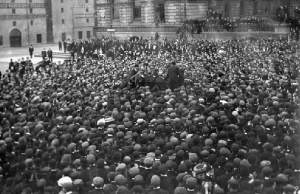
When a dock strike called by Jim Larkin brought Belfast to a standstill. By John Dorney
The Belfast docks strike of 1907 has entered into legend in the realm of Irish labour history.
According to the legend, ‘Big Jim’ Larkin, newly arrived from Liverpool, descended on the city like a biblical prophet, uniting Catholic and Protestant workers against tyrannical bosses.
He is supposed to have led joint a parade of Catholic and Protestants, Orangemen and nationalists, together on the Twelfth of July and was so successful an agitator that he induced the Royal Irish Constabulary themselves to go on strike in sympathy with the dockers.
The Belfast docks strike of 1907 has entered into legend in the realm of Irish labour history.
Unfortunately, none of this is quite true. Though the Orange parades on the Twelfth were unusually peaceful that year, the mass rally of the Belfast trade unionists took place on July 26, not July 12. Though the police did go on strike, Larkin had nothing to do with it and was not even in Belfast at the time.
But the Belfast dockers and carters strike of 1907 did indeed see a crack open in that city’s long-standing sectarian divisions and Larkin really did unite Orangemen and Republicans on the same platform, at least for a time, before that window snapped shut again.
For several months the Belfast docks, Ireland’s busiest at that time, were the scene of a violent and bitter struggle that centred on the right of unskilled labourers to organise in unions. The 1907 strike can, indeed, be said to be the opening chapter in the independent Irish trade union movement, and a precursor of the great Lockout in Dublin in 1913.
Belfast
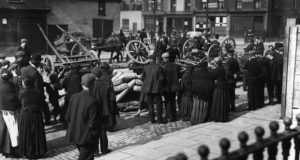
Belfast, at the turn of the twentieth century, was Ireland’s only industrial city of note, and was described by its Lord Mayor as ‘an Elysium [paradise] for the working classes’.[1]
Unlike Dublin, where much of the labouring population lived in appalling slum conditions, Belfast’s working classes generally had more modern and healthy housing.
Whereas 35% of Dublin’s population lived in one room tenements, only 1% of Belfast’s did.[2] Relatively well paid and secure employment was available at the city’s shipyards, and less well paid, but still abundant, work at Belfast’s textile factories.
Though conditions among skilled workers in Belfast were good, the unskilled suffered from low pay and casual employment.
Yet for the unskilled workers of Belfast, especially on the docks, all was not well. Dockers had no secure contracts, but effectively had to haggle each day for the right to be hired and had no set rate for the work they did. They were to be unsurprisingly receptive to the message of militant trade unionism.
The carters, who drove horse-drawn carts to and from the docks, were slightly better off, but not much. In 1907 there were about 1,500 carters, of whom one third were employed by the Belfast shipping companies but most were employed by small firms belonging to the Belfast Master Carriers’ Association. A carter typically earned between 19 and 22 shillings per week, though they were docked pay if any of their cargo was broken. [3]
And Belfast also, of course, had deep ingrained sectarian divisions. The shipyards, the bastions of well paid skilled working class jobs were dominated by Protestants and unionists. In 1886, and as recently as 1893, when the House of Commons proposed a Home Rule Bill there was bloody rioting at the shipyards, in which dozens of people were killed and most of the Catholic workers driven out of their jobs. [4]
Nor was it just the shipyards where religion divided the workers. Historian Emmet O’Connor writes, ‘Carting was a superior, more “Protestant” occupation’ than docking’. While on the docks themselves, there was a certain amount of sectarian division among the 3,100 dockers. The cross channel dockers were generally Protestant, while the ‘deep sea’ dockers whose work was more casual, were more often Catholic.[5]
The carters were represented up to the early 1900s by the conservative Carter’s Society, but in the first decade of the new century, they were beginning to be superseded by the ‘new unionism’ which tried to combine workers in large unions across workplace and trade.
The dockers, had no union representation whatsoever up to 1907. However, all this was to change with the arrival of James ‘Big Jim’ Larkin in the city.
Larkin
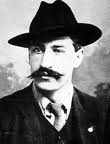
Larkin, a Liverpool born Irishman, stepped off the ferry in Belfast on 20 January 1907. He was a big man, 33 years old, hardened by years of work on the Liverpool docks, a committed socialist and a representative of the National Union of Dock Labourers or NUDL. He had been sent to Belfast by James Sexton, the union’s general secretary, to organise the dock labourers there.
Larkin struck contemporaries as an imposing figure. He sported a wide brimmed hat, long black coat and a drooping moustache. He spoke ‘in the approved manner of the English slums’, but among Irish workers he rapidly gained a reputation as a speaker of extraordinary emotional power.
As well as a socialist, Larkin was also a teetotaler and a stern moralist. One of his first priorities was to end the practice of dockers being paid in pubs.
James Larkin, a socialist, firebrand trade unionist and stern moralist was sent to Belfast by the National Union of Dock Labourers in early 1907.
At a series of street corner meetings on the docks, Larkin set about recruiting dockers to the NUDL. Doubtless he argued that they were underpaid and had no job security, that they and their families deserved better. Whatever it was he told them, over a period of just few months, Larkin managed very quickly to recruit almost all, 2,900 out of 3,100, of Belfast’s dockers, both Catholic and Protestant.
It was not just Larkin’s ardour for social change or the conditions of Belfast dockers that made this possible. In 1906, the Liberal Government had reversed a Conservative law of 1901 that made trade unions liable to be sued for financial damage caused by strikes. Now they would again have immunity from legal action and could picket legally. [6]
Secondly, 1907 was an unusually fortuitous time to organise Catholics and Protestants together. The question of Home Rule or Irish self-government, had been shelved since 1893, easing tensions between nationalists and unionists. There had also been a split within the Orange Order, where an independent Orange Order had emerged, a more working class organisation that championed trade unionism and even some sort of Irish self government.[7]
Alex Boyd an Independent Orangeman and city councillor, would be one of Larkin’s key allies during the dock strike.
Strike
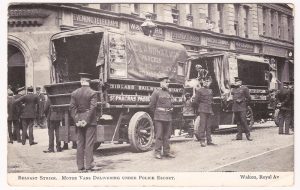
Larkin developed a reputation as a firebrand labour leader, willing to call a sympathetic strike at the first hint of a dispute. But in fact, as his most recent biographer, Emmet O’Connor, has argued, he was usually cautious in calling strikes, preferring to gain pay rises and other concessions by careful negotiations rather than risk the union’s reserves of money in strikes. [8]
The trouble on the Belfast docks in fact began as a result of unauthorised grassroots action in April of 1907 when a number of NUDL members working at Kelly’s Coal Quay refused to work with non-union men and walked off the job. Larkin not only disapproved and ordered the men to go back to work, but actually apologised to company.
The dispute began with an unauthorised strike by dockers who did not want to work with non union men.
For the shipping and docking companies, though, led by shipping magnate Thomas Gallaher, the ill-advised strike was a chance to break the new union, and they sacked the men concerned. Larkin called a strike in protest and it spread along the docks when the shipping companies began to lock out union members and to bring in ‘blackleg’ i.e. non-union workers from Liverpool to pass the picket.
Thomas Johnson, a veteran labour organiser, recalled, ‘the Shipping Federation which was an organisation of ship-owning employers…organised ‘blacklegs’ or ‘scabs’ and lodged them in steamship which lay alongside the quays’.[9]
There were extremely violent clashes throughout May between striking dockers and ‘scabs’. Dockers boarded ships by force and in a ‘fusillade of missiles’, prevented the ‘blacklegs’ or strike breakers from unloading their cargo. Larkin himself was arrested for ‘assault and battery’ for hitting a blackleg named Bamber with a stone after the latter had stabbed three dockers with a knife.[10]
Larkin upped the ante on June 21 when he called a general strike of dockers and also demanded a pay rise. It was at this point that the first carters struck in sympathy with the dockers, with 200 men at Fleetwood Quay going out on strike in protest at having to work with ‘scabs’.[11]
The Master Carriers Association tried to drive a wedge between the dockers and the carters by offering the latter a pay rise if they would go back to work beside the non-union men, but on July 4, over 1,000 carters in over 60 firms went out on strike for the principle of union recognition on the docks.
It escalated into a general strike of both dockers and carters when the employers attempted to lock out all NUDL members.
The strike marked the eclipse of the old Carters’ Society as a representative of the Carters as many of them joined the NUDL.[12]
The employers attempted to bring ‘traction machines’ a kind of steam engine to replace the carters as well as non-unionised carts. This led to bitter rioting all over Belfast as strikers attacked and overturned the ‘scab’ carts.
One striker, Billy Hunter, recalled many years later that the traction engines were halted by throwing heavy planks across their path and that lorries were set on fire or thrown into the river Lagan. One woman ‘scab’ was thrown into a horse trough, ‘she did not try it again’, he recalled.[13]
Non-sectarian
The strike was a rare case of non-sectarian mobilisation in Belfast. This unity more or less held during the strike despite the unionist press’s claim that Larkin was really a nationalist agitator.
The unionist newspapers even alleged that Larkin was related to Michael Larkin, one of the Fenian ‘Manchester Martyrs’ who were executed in 1867. To allay Protestant fears of a ‘Fenian plot’, Larkin even stepped aside in favour of Independent Orangemen Alex Boyd during a critical point of the strike. [14]
Larkin, though from an Irish Catholic background, had strong Protestant support, including from the Independent Orange Order.
And in the wake of the dispute, the employers even tried to launch an Protestant-only union the Belfast Coal workers and Carters’ Benefit Society, in order to divide the workers along sectarian lines. As it was though, the carters struck in protest and the scheme came to nothing.[15]
Larkin, though he was from an Irish Catholic background in Liverpool, had strong cross community support in Belfast. On the Twelfth of July, 1,000 Orangemen signed a letter stating, ‘it is our fervent prayer that James Larkin may long be spared to work for the emancipation of unskilled workers in his native land’.[16] On July 26, 1907, two weeks after the Orange Order demonstration on the Twelfth, Larkin led a labour parade, reportedly 100,000 strong, that made its way through the Catholic Falls and Protestant Shankill districts of the city, along with the Independent Orange Order and was applauded in both neighbourhoods.[17]
Interestingly, Larkin also seems to have met the ‘advanced nationalists’ of the Dungannon Clubs, a front for the Irish Republican Brotherhood, to secure their support. Liam Gaynor a Dungannon Club member recalled, ‘Larkin spoke at some length about the importance of organising Irish labour and insisted that this was more important at the time than organising for Irish freedom’. The separatists were, on the whole, uninterested, though, in Larkin’s message of socialism. According to Gaynor, ‘the members of the Dungannon Club earned only a very modest livelihoods but they were confirmed in their view that freedom was more important than improving social conditions.’[18]
Nationalist politicians, including Belfast MP Joe Devlin, generally only became involved in the strike by objecting vociferously to the deployment of British Army troops to police it.
Police strike
The RIC, partly because they were overwhelmed by the dispute, but also because of a longstanding series of work related grievances of their own, principally low pay and long hours, themselves ‘downed tools’ in protest and went on strike on July 24. Some 600 police officers took over Musgrave Street police barracks and invited strikers in to discuss the dispute with them. [19]
Though Larkin himself was in Liverpool at the time, he has often got the credit in popular memory for getting the police to join the strike.
At the height of the docks strike, the police in Belfast themselves went on strike, leading to 6,000 British troops being sent to the city.
Augustine Birrell, the Chief Secretary for Ireland, the most senior British official in Ireland, had taken the view that the government would not intervene in the strike, blaming it on the ‘refusal of the employers to meet with trade union leaders’. But once the police went on strike the British administration had to act quickly to prevent a complete breakdown of law and order in Ireland’s second city. The result was that over 6,000 British Army troops were drafted into Belfast to ‘restore order’.[20]
While police were trained to deal with public order situations, the military was not and tended to be more violent in their handling of strikers. Labour historian Desmond Greave commented that while RIC allowed strikers to appeal to strike breakers not to pass pickets, if a striker grabbed the bridle of a horse taking goods from the docks under military escort, they were ‘clubbed to the ground’ with rifle butts.[21]
Many nationalists thought that the deployment of the military, especially in the Catholic Falls Road, far from the docks, was a deliberate provocation, designed to break the cross-sectarian unity of the strike by starting rioting between nationalists and the Army. IRB man Liam Gaynor thought that, ‘the authorities became alarmed and endeavoured to break up the solidarity gained by Mr Larkin by introducing sectarianism into the strike. This was done by deliberately placing large forces of British soldiers in the Catholic Falls Road area to incite the people’. [22]
Whether deliberate provocation or not, rioting did indeed result between the troops and the nationalist residents of the Falls area. The soldiers ultimately opened fire a stone throwing crowd on the Falls Road, shooting dead two people and wounding five.[23]
Settlement
The violence made the British government anxious to settle the dispute. There was a perception in both government and trade union circles that the dispute had got out of hand. James Sexton the head of the NUDL, travelled to Belfast while the government dispatched the negotiator George Askwith who specialised in resolving industrial disputes.
The carters settled before the dockers. On August 15, Larkin and the NUDL national leader James Sexton met the Askwith.
James Sexton the NUDL General Secretary tried to exclude Larkin, regarded as troublemaker, from negotiations.
Larkin it seems was excluded from the carters’ settlement. At a subsequent meeting in St Mary’s Hall, Sexton (reportedly carrying two revolvers in case of trouble) persuaded the carters to go back to work in return for a pay rise and shorter working hours, but that they would have to accept working beside non-union men.
The dockers themselves went back to work on August 28, in some cases with pay rises, but in many cases with the sacking of ‘troublemakers’ and all dockers had to accept working with non-union men.[24]
The strike was over, but there was another brief dispute in November when dockers in Belfast refused to handle goods loaded by ‘scabs’ in Newry. This time, Sexton, eager to avoid another potentially explosive dispute, excluded Larkin from the start from negotiations and ordered the men back to work.
Post Script
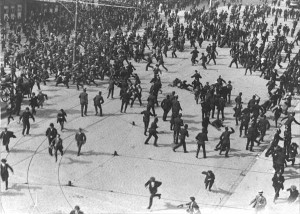
The immediate fallout from the Belfast strike was inconclusive, the NUDL was established on the docks, though some of its members lost their jobs. Nor was there a pay rise or significant improvement in working conditions for dockers or carters despite all the hardship and violence that the strike had involved.
The policemen who struck in July 1907 were severely punished: one was sacked outright, six others suspended and 150 constables were ‘rusticated’ or suspended for a shorter period of time.[25]
Larkin was expelled from the NUDL and went on to found the Irish Transport and General Workers Union.
The most lasting consequence of the strike was James Larkin’s decision to strike out on his own and found the Irish Transport and General Workers Union (ITGWU) in 1909. Larkin believed that he had not been supported adequately by the NUDL during the dispute, or in his own subsequent court case, in which he was convicted of assault on a strike breaker.
Following further disputes with Sexton, after he had authorised two more strikes, contrary to the wishes of the NUDL leadership, in Derry and Cork, he was dismissed from that union. The official charge was that he had embezzled union money, though this was never proved. Henceforth he would argue that Irish workers should join Irish unions only.
The solidarity the strike engendered in Belfast across the sectarian divide did not last. In the wake of the 1907 strike Tom Sloan, the founder of the Independent Orange Order, disowned Larkin and Lindsay Crawford the Independent Orangeman and journalist who had written supportively of Larkin and the strike, was sacked from his position as Grandmaster of the organisation. The other Independent Orange leader, Alex Boyd, though he too repudiated Larkin, lost his seat on the municipal council in 1908.[26]
While Orangemen like Alex Boyd had joined Larkin on platforms throughout the dockers strike, most afterwards came to regard him as a dangerous nationalist. They were particularly opposed to Protestant workers joining the ITGWU, which Boyd called ‘a Sinn Fein [i.e. separatist] organisation that not even a decent nationalist in Belfast would have anything to do with’. [27]
Many Catholic dockers in Belfast joined the ITGWU, but most Protestants stayed with the NUDL (which later became part of the Amalgamated Trasnport and General Workers Union), splitting trade unionism on the docks along more or less sectarian lines. The strength of Larkin’s new union, that aimed to organise all unskilled workers, would be in the south, particularly in Dublin, not in Belfast.
If 1907 was a false dawn in Belfast, it was, however, the harbinger of a new era of militant trade unionism in Ireland that would go on to help shape the island in the next two decades.
References
[1] John Gray, City in Revolt, Belfast 1907 in Donal Nevin, Ed, James Larkin, Lion of the Fold, (1998) p.25
[2] Emmet O’Connor, Big Jim Larkin, Hero or Wrecker? (2016), p.23
[3] John Gray, A City in Revolt, James Larkin and the Belfast Dock Strike of 1907 (1985), p.7
[4] See Belfast Riots – A Short History.
[5] Emmet O’Connor, Big Jim Larkin, Hero or Wrecker? (2016), p.28
[6] C Desmond Greaves, Irish Transport and General Workers Union the Formative Years, p.8
[7] O’Connor, Big Jim. P.25
[8] O’Connor, Big Jim, p.28-30
[9] Thomas Johnson WS 1755 Bureau of Military History
[10] Greaves, Irish Transport and General Workers Union, p.14
[11] O’Connor, Big Jim, p.30-32
[12] Gray, A City in Revolt, p.7
[13] Nevin, The Lion of the Fold, p.147
[14] Gray A City in Revolt p.79-80
[15] O’Connor, Big Jim, p.36
[16] Gray, in Nevin, Lion of the Fold, p26.
[17] O’Connor, Big Jim p.33
[18] Liam Gaynor WS 183 BMH
[19] Gray, A City in Revolt, p.95
[20] John Gray, in Donal Nevin, ed. James Larkin the Lion of the Fold, p.25
[21] C Desmond Greaves, Irish Transport and General Workers Union the Formative Years, p.16
[22] Liam Gaynor BMH
[23] O’Connor, Big Jim p.34
[24] For settlement of the strike see O’Connor p.35, Gray A City in Revolt p.173
[25] Greaves, ITGWU. P.17
[26] History Ireland, Remembering Larkin and the dock strike of 1907. https://www.historyireland.com/20th-century-contemporary-history/remembering-larkin-and-the-dock-strike-of-1907/
[27] O’Connor, Big Jim, p.55